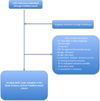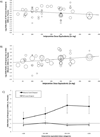Systematic Review and Meta-Analysis: Dose-Response Relationship of Selective Serotonin Reuptake Inhibitors in Major Depressive Disorder
- PMID: 26552940
- PMCID: PMC4975858
- DOI: 10.1176/appi.ajp.2015.15030331
Systematic Review and Meta-Analysis: Dose-Response Relationship of Selective Serotonin Reuptake Inhibitors in Major Depressive Disorder
Abstract
Objective: Previous studies suggested that the treatment response to selective serotonin reuptake inhibitors (SSRIs) in major depressive disorder follows a flat response curve within the therapeutic dose range. The present study was designed to clarify the relationship between dosage and treatment response in major depressive disorder.
Method: The authors searched PubMed for randomized placebo-controlled trials examining the efficacy of SSRIs for treating adults with major depressive disorder. Trials were also required to assess improvement in depression severity at multiple time points. Additional data were collected on treatment response and all-cause and side effect-related discontinuation. All medication doses were transformed into imipramine-equivalent doses. The longitudinal data were analyzed with a mixed-regression model. Endpoint and tolerability analyses were analyzed using meta-regression and stratified subgroup analysis by predefined SSRI dose categories in order to assess the effect of SSRI dosing on the efficacy and tolerability of SSRIs for major depressive disorder.
Results: Forty studies involving 10,039 participants were included. Longitudinal modeling (dose-by-time interaction=0.0007, 95% CI=0.0001-0.0013) and endpoint analysis (meta-regression: β=0.00053, 95% CI=0.00018-0.00088, z=2.98) demonstrated a small but statistically significant positive association between SSRI dose and efficacy. Higher doses of SSRIs were associated with an increased likelihood of dropouts due to side effects (meta-regression: β=0.00207, 95% CI=0.00071-0.00342, z=2.98) and decreased likelihood of all-cause dropout (meta-regression: β=-0.00093, 95% CI=-0.00165 to -0.00021, z=-2.54).
Conclusions: Higher doses of SSRIs appear slightly more effective in major depressive disorder. This benefit appears to plateau at around 250 mg of imipramine equivalents (50 mg of fluoxetine). The slightly increased benefits of SSRIs at higher doses are somewhat offset by decreased tolerability at high doses.
Conflict of interest statement
Figures




Comment in
-
Dose Response for SSRIs.Am J Psychiatry. 2016 Feb 1;173(2):105-6. doi: 10.1176/appi.ajp.2015.15121535. Am J Psychiatry. 2016. PMID: 26844791 No abstract available.
-
Addressing Difficulties in the Study of Dose-Response Relationships of SSRIs in Depression: Response to Hieronymus and Eriksson.Am J Psychiatry. 2016 Aug 1;173(8):836-8. doi: 10.1176/appi.ajp.2016.16030304r. Am J Psychiatry. 2016. PMID: 27477138 No abstract available.
-
Inclusion of Flexible-Dose Trials in the Meta-Analysis of SSRI Dose-Dependency.Am J Psychiatry. 2016 Aug 1;173(8):836. doi: 10.1176/appi.ajp.2016.16030304. Am J Psychiatry. 2016. PMID: 27477139 No abstract available.
Similar articles
-
Pharmacological treatments in panic disorder in adults: a network meta-analysis.Cochrane Database Syst Rev. 2023 Nov 28;11(11):CD012729. doi: 10.1002/14651858.CD012729.pub3. Cochrane Database Syst Rev. 2023. PMID: 38014714 Free PMC article.
-
Selective serotonin reuptake inhibitors (SSRIs) for stroke recovery.Cochrane Database Syst Rev. 2012 Nov 14;11(11):CD009286. doi: 10.1002/14651858.CD009286.pub2. Cochrane Database Syst Rev. 2012. Update in: Cochrane Database Syst Rev. 2019 Nov 26;2019(11). doi: 10.1002/14651858.CD009286.pub3. PMID: 23152272 Free PMC article. Updated.
-
New generation antidepressants for depression in children and adolescents: a network meta-analysis.Cochrane Database Syst Rev. 2021 May 24;5(5):CD013674. doi: 10.1002/14651858.CD013674.pub2. Cochrane Database Syst Rev. 2021. PMID: 34029378 Free PMC article.
-
Selective serotonin reuptake inhibitors (SSRIs) for depressive disorders in children and adolescents.Cochrane Database Syst Rev. 2007 Jul 18;(3):CD004851. doi: 10.1002/14651858.CD004851.pub2. Cochrane Database Syst Rev. 2007. Update in: Cochrane Database Syst Rev. 2012 Nov 14;11:CD004851. doi: 10.1002/14651858.CD004851.pub3. PMID: 17636776 Updated.
-
Newer generation antidepressants for depressive disorders in children and adolescents.Cochrane Database Syst Rev. 2012 Nov 14;11(11):CD004851. doi: 10.1002/14651858.CD004851.pub3. Cochrane Database Syst Rev. 2012. PMID: 23152227 Free PMC article.
Cited by
-
Dose-response effects of selective serotonin reuptake inhibitor monotherapy for the treatment of depression: systematic review of reviews and meta-narrative synthesis.BMJ Med. 2022 Dec 1;1(1):e000017. doi: 10.1136/bmjmed-2021-000017. eCollection 2022. BMJ Med. 2022. PMID: 36936596 Free PMC article.
-
Clinical guidelines for the management of treatment-resistant depression: French recommendations from experts, the French Association for Biological Psychiatry and Neuropsychopharmacology and the fondation FondaMental.BMC Psychiatry. 2019 Aug 28;19(1):262. doi: 10.1186/s12888-019-2237-x. BMC Psychiatry. 2019. PMID: 31455302 Free PMC article.
-
Venlafaxine ER Blocks the Norepinephrine Transporter in the Brain of Patients with Major Depressive Disorder: a PET Study Using [18F]FMeNER-D2.Int J Neuropsychopharmacol. 2019 Apr 1;22(4):278-285. doi: 10.1093/ijnp/pyz003. Int J Neuropsychopharmacol. 2019. PMID: 30649319 Free PMC article.
-
Effects of Antidepressants on Sleep in Post-traumatic Stress Disorder: An Overview of Reviews.Curr Neuropharmacol. 2024;22(4):749-805. doi: 10.2174/1570159X21666230801144328. Curr Neuropharmacol. 2024. PMID: 37533247 Free PMC article. Review.
-
The Association Between Antidepressant Effect of SSRIs and Astrocytes: Conceptual Overview and Meta-analysis of the Literature.Neurochem Res. 2021 Oct;46(10):2731-2745. doi: 10.1007/s11064-020-03225-6. Epub 2021 Feb 1. Neurochem Res. 2021. PMID: 33527219
References
-
- Kessler RC, Berglund P, Demler O, Jin R, Merikangas KR, Walters EE. Lifetime prevalence and age-of-onset distributions of DSM-IV disorders in the National Comorbidity Survey Replication. Archives of general psychiatry. 2005;62:593–602. - PubMed
-
- Alan J, Gelenberg MD, Chair, Marlene P, Freeman MD, John C, Markowitz MD, Jerrold F, Rosenbaum MD, Michael E, Thase MD, Madhukar H, Trivedi MD, Richard S, Van Rhoads MD., Consultant Practice Guideline for the Treatment of Patients with Major Depressive Disorder. 2010
-
- NICE. London: National Institute for Health and Care Excellence; 2009. Depression - The treatment and management of depression in adults. - PubMed
-
- Marcus SC, Olfson M. National trends in the treatment for depression from 1998 to 2007. Archives of general psychiatry. 2010;67:1265–1273. - PubMed
Publication types
MeSH terms
Substances
Grants and funding
LinkOut - more resources
Full Text Sources
Other Literature Sources

